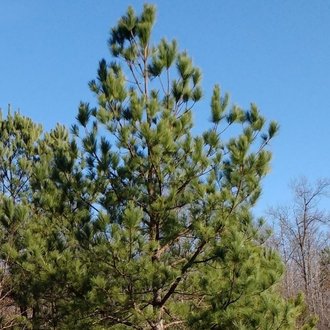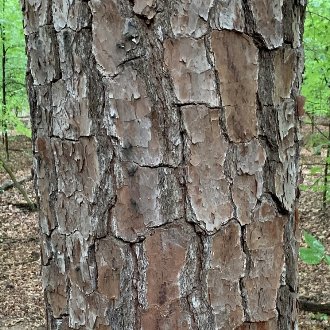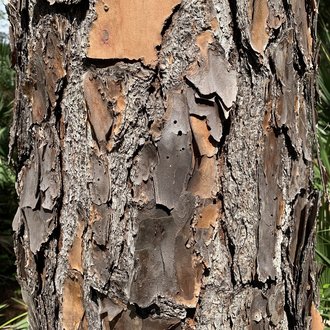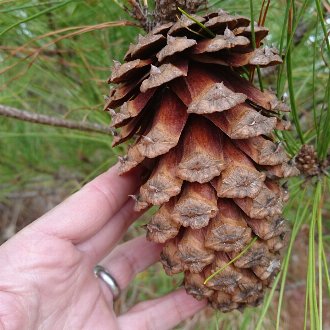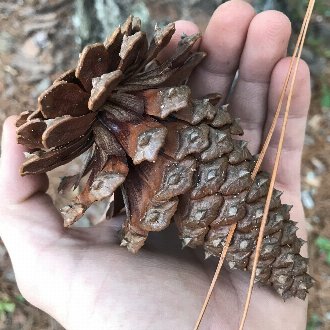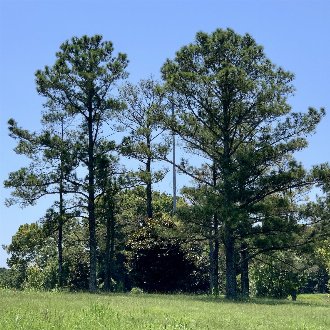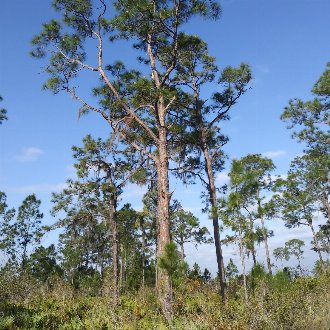Loblolly Pine vs Slash Pine
These pines are sometimes confused; both grow on wet, poorly-drained sites and have needles of roughly similar length. They are easily distinguished by bark and growth habit, and can also usually be distinguished by needle count and characteristics of fresh cones. P. taeda ranges farther north and is less fire-tolerant, whereas P. elliotti ranges farther south and is more fire-tolerant.
Loblolly Pine (Pinus taeda) | Slash Pine (Pinus elliottii) |
A pine native to the southeastern US, favoring moist bottomlands, also widely planted in forestry. | A fast-growing, short-lived pine native to mesic flatwoods and moist, poorly-drained sites in the southeastern coastal plain. |
Needles consistently in bundles of 3. Photo © Samuel A. Schmid, CC BY 4.0. | Needles may be in bundles of 2 or 3, often with examples of both on the same twig. Photo © Bill Michalek, Public Domain. |
Crown branches mostly proceed from the trunk at upward angles, and often curve slightly, curving either upwards or downwards. Crowns are usually denser, and have more numerous, smaller branches. Photo © lapemis, Public Domain. | Crown branches proceed from trunk at different angles, and are mostly straight, but sometimes make abrupt angles or branch irregularly. Crowns are usually more open, and have fewer, heavier branches. Photo © Andrew Durso, CC BY 4.0. |
Foliage extends farther down twigs before it stops, reflecting the fact that needles are retained for 3 years. Photo © Ken-ichi Ueda, CC BY 4.0. | Foliage more concentrated at tips of twigs, reflecting the fact that needles are usually only retained for 2 years. Photo © Kim, CC BY 4.0. |
Bark is more uniform reddish-brown in color. Bark plates tend to be scaly and do not flake off as much. Photo © Jeff Clark, CC BY 4.0. | Bark is more colorful, with contrasting purplish-brown and orangeish-brown sections. Bark plates often flake off in broad, papery sheets. Photo © mark-groeneveld, CC BY 4.0. |
Cones average slightly smaller (6-12cm) although with significant overlap in size. Photo © Abby Darrah, CC BY 4.0. | Cones average slightly larger (9-18cm, rarely 7-20cm) although with significant overlap in size. Photo © Clara Dandridge, CC BY 4.0. |
Trunk usually remains straight even into the crown. | Trunk is usually very straight until the crown, but sometimes becomes contorted in the crown. Photo © Austin Pursley, Public Domain. |
Even on fresh cones, outer surfaces are not as shiny. Prickles on cone scales tend to be larger. Photo © Sarah DeLong-Duhon, CC BY 4.0. | On fresh cones, outer surfaces are more glossy or shiny. Prickles on cone scales tend to be smaller. Photo © Kent McFarland, Public Domain. |
Trees do not self-prune as aggressively, retaining many lower branches as long as they are not shaded out. Photo © CK Kelly, CC BY 4.0. | Trees aggressively self-prune even when growing in full sun; mature trees lack lower branches even in sunny habitats. Photo © Daniel Estabrooks, Public Domain. |
Additional Notes
The differences in growth habit of these two species reflects the tendency of P. elliottii to grow in more fire-prone habitats: the aggressive self-pruning of lower branches keeps ground fires from spreading into the canopy. P. taeda is somewhat less fire-tolerant, relying on moisture-rich foliage to keep fire out of its crown. As such, although it tolerates low-intensity ground fires, it is mostly limited to habitats less prone to severe fire, so it benefits from the extra photosynthetic capacity associated with retaining lower branches. These differences also correspond to range and climate: as one progresses farther south in Florida, the dry season becomes longer and drier and thunderstorms more severe, so early-season fire can occur in habitats that are progressively wetter during the growing season.References & External Resources
These short lists show only links helpful for ID. For a complete list of references and resources also covering other aspects of ecology, visit the links section of the full article on each plant, which is the first entry here.







